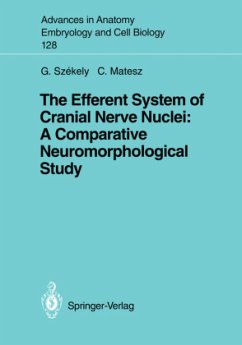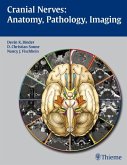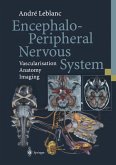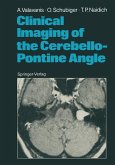George Szekely, Clara Matesz
The Efferent System of Cranial Nerve Nuclei: A Comparative Neuromorphological Study
George Szekely, Clara Matesz
The Efferent System of Cranial Nerve Nuclei: A Comparative Neuromorphological Study
- Broschiertes Buch
- Merkliste
- Auf die Merkliste
- Bewerten Bewerten
- Teilen
- Produkt teilen
- Produkterinnerung
- Produkterinnerung
A new approach using comparative neuromorphology is taken inthis study dealing with the organization of the efferentnuclei of cranial nerves. The authors use the cobaltlabelling technique to identify neuron types and followtheir presence, or absence, in different animal species.They suggest a new classification which is free from anumber of controversies inherent in the classicalclassification. The results suggest that evolutionarychanges in the center and in the innervated peripharyparallel each other with increasingly complex function.
Andere Kunden interessierten sich auch für
![Clinical Anatomy of the Cranial Nerves Clinical Anatomy of the Cranial Nerves]() Paul ReaClinical Anatomy of the Cranial Nerves44,99 €
Paul ReaClinical Anatomy of the Cranial Nerves44,99 €![Cranial Nerves: Anatomy, Pathology, Imaging Cranial Nerves: Anatomy, Pathology, Imaging]() Devin K. BinderCranial Nerves: Anatomy, Pathology, Imaging97,90 €
Devin K. BinderCranial Nerves: Anatomy, Pathology, Imaging97,90 €![Funktionelle Anatomie der Hirnnerven und des vegetativen Nervensystems für Mediziner und Zahnmediziner Funktionelle Anatomie der Hirnnerven und des vegetativen Nervensystems für Mediziner und Zahnmediziner]() Farhang SamandariFunktionelle Anatomie der Hirnnerven und des vegetativen Nervensystems für Mediziner und Zahnmediziner49,95 €
Farhang SamandariFunktionelle Anatomie der Hirnnerven und des vegetativen Nervensystems für Mediziner und Zahnmediziner49,95 €![Development of the Cranial Nerve Ganglia and Related Nuclei in the Rat Development of the Cranial Nerve Ganglia and Related Nuclei in the Rat]() Joseph AltmanDevelopment of the Cranial Nerve Ganglia and Related Nuclei in the Rat39,99 €
Joseph AltmanDevelopment of the Cranial Nerve Ganglia and Related Nuclei in the Rat39,99 €![Encephalo-Peripheral Nervous System Encephalo-Peripheral Nervous System]() André LeblancEncephalo-Peripheral Nervous System112,99 €
André LeblancEncephalo-Peripheral Nervous System112,99 €![The Auditory System in Sleep The Auditory System in Sleep]() Ricardo VellutiThe Auditory System in Sleep66,99 €
Ricardo VellutiThe Auditory System in Sleep66,99 €![Clinical Imaging of the Cerebello-Pontine Angle Clinical Imaging of the Cerebello-Pontine Angle]() Anton ValavanisClinical Imaging of the Cerebello-Pontine Angle77,99 €
Anton ValavanisClinical Imaging of the Cerebello-Pontine Angle77,99 €-
-
-
A new approach using comparative neuromorphology is taken inthis study dealing with the organization of the efferentnuclei of cranial nerves. The authors use the cobaltlabelling technique to identify neuron types and followtheir presence, or absence, in different animal species.They suggest a new classification which is free from anumber of controversies inherent in the classicalclassification. The results suggest that evolutionarychanges in the center and in the innervated peripharyparallel each other with increasingly complex function.
Produktdetails
- Produktdetails
- Advances in Anatomy, Embryology and Cell Biology .128
- Verlag: Springer / Springer Berlin Heidelberg / Springer, Berlin
- Artikelnr. des Verlages: 978-3-540-56207-8
- 1993.
- Seitenzahl: 104
- Erscheinungstermin: 3. März 1993
- Englisch
- Abmessung: 242mm x 170mm x 7mm
- Gewicht: 240g
- ISBN-13: 9783540562078
- ISBN-10: 3540562079
- Artikelnr.: 36111745
- Herstellerkennzeichnung Die Herstellerinformationen sind derzeit nicht verfügbar.
- Advances in Anatomy, Embryology and Cell Biology .128
- Verlag: Springer / Springer Berlin Heidelberg / Springer, Berlin
- Artikelnr. des Verlages: 978-3-540-56207-8
- 1993.
- Seitenzahl: 104
- Erscheinungstermin: 3. März 1993
- Englisch
- Abmessung: 242mm x 170mm x 7mm
- Gewicht: 240g
- ISBN-13: 9783540562078
- ISBN-10: 3540562079
- Artikelnr.: 36111745
- Herstellerkennzeichnung Die Herstellerinformationen sind derzeit nicht verfügbar.
1 Introduction.- 1.1 Theories Regarding the Evolution of the Head.- 1.2 The Classification of Cranial Nerves.- 1.3 Inconsistencies and Contradictions in the Classification of Cranial Nerves.- 2 Materials and Methods.- 3 The Hypoglossal Nucleus: The Appearance of the Muscular Tongue.- 3.1 Frog.- 3.2 Lizard.- 3.3 Rat.- 3.4 Conclusion.- 4 The Control of Patterned Eye Movements: The Oculomotor, Trochlear, and Abducens Nuclei.- 4.1 The Positions of the Eye Moving Nuclei and the Organization of Muscle Innervation.- 4.2 Neuronal Morphology in the Eye Moving Nuclei.- 4.3 Conclusion.- 5 The Protection of the Eye: The Accessory Abducens Nucleus.- 5.1 The Position of the Accessory Abducens Nucleus.- 5.2 The Neuronal Morphology in the Accessory Abducens Nucleus.- 5.3 The Function of the Accessorius Abducens-Retractor Bulbi System.- 5.4 Conclusion.- 6 Control of Jaw Movements and Facial Expression: The Trigeminal and Facial Nuclei.- 6.1 The Primary Mandibular Joint and Its Muscles.- 6.2 The Secondary Mandibular Joint and Its Muscles.- 6.3 The Control of Movements at the Primary Mandibular Joint: The Amphibian and Sauropsidian Trigeminal and Facial Nuclei.- 6.4 The Control of Movement at the Secondary Mandibular Joint: The Mammalian Trigeminal Nucleus.- 6.5 The Control of Facial Expression: The Mammalian Facial Nucleus.- 6.6 Conclusion.- 7 The Muscles of the Middle Ear.- 7.1 The Central Innervation of the Tensor Tympani.- 7.2 The Central Innervation of the Stapedius.- 7.3 Conclusion.- 8 Deglutition and Phonation: The Ambiguus Nucleus.- 8.1 The Innervated Periphery.- 8.2 The Structure and Cytoarchitecture of the Ambiguus Nucleus.- 8.3 Conclusion.- 9 The Control of Head Movements: The Accessory Nerve Nucleus.- 9.1 The Periphery.- 9.2 The Accessory Nerve.- 9.3 The Topography and Cytoarchitecture of the Accessory Nerve Nucleus.- 10 Neurons of the Cranial Parasympathetic Outflow.- 10.1 The Edinger-Westphal Nucleus and Ciliary Ganglion System.- 10.2 The Medullary Parasympathetic Outflow.- 10.3 Conclusion.- 11 General Conclusions.- 11.1 The Arrangement of Cranial Nerve Motor Nuclei.- 11.2 Comments on the Morphological Classification.- 11.3 Trends in the Evolution of Cranial Nerve Nuclei.- 11.4 Corollary Considerations.- 11.5 Summary.- References.
1 Introduction.- 1.1 Theories Regarding the Evolution of the Head.- 1.2 The Classification of Cranial Nerves.- 1.3 Inconsistencies and Contradictions in the Classification of Cranial Nerves.- 2 Materials and Methods.- 3 The Hypoglossal Nucleus: The Appearance of the Muscular Tongue.- 3.1 Frog.- 3.2 Lizard.- 3.3 Rat.- 3.4 Conclusion.- 4 The Control of Patterned Eye Movements: The Oculomotor, Trochlear, and Abducens Nuclei.- 4.1 The Positions of the Eye Moving Nuclei and the Organization of Muscle Innervation.- 4.2 Neuronal Morphology in the Eye Moving Nuclei.- 4.3 Conclusion.- 5 The Protection of the Eye: The Accessory Abducens Nucleus.- 5.1 The Position of the Accessory Abducens Nucleus.- 5.2 The Neuronal Morphology in the Accessory Abducens Nucleus.- 5.3 The Function of the Accessorius Abducens-Retractor Bulbi System.- 5.4 Conclusion.- 6 Control of Jaw Movements and Facial Expression: The Trigeminal and Facial Nuclei.- 6.1 The Primary Mandibular Joint and Its Muscles.- 6.2 The Secondary Mandibular Joint and Its Muscles.- 6.3 The Control of Movements at the Primary Mandibular Joint: The Amphibian and Sauropsidian Trigeminal and Facial Nuclei.- 6.4 The Control of Movement at the Secondary Mandibular Joint: The Mammalian Trigeminal Nucleus.- 6.5 The Control of Facial Expression: The Mammalian Facial Nucleus.- 6.6 Conclusion.- 7 The Muscles of the Middle Ear.- 7.1 The Central Innervation of the Tensor Tympani.- 7.2 The Central Innervation of the Stapedius.- 7.3 Conclusion.- 8 Deglutition and Phonation: The Ambiguus Nucleus.- 8.1 The Innervated Periphery.- 8.2 The Structure and Cytoarchitecture of the Ambiguus Nucleus.- 8.3 Conclusion.- 9 The Control of Head Movements: The Accessory Nerve Nucleus.- 9.1 The Periphery.- 9.2 The Accessory Nerve.- 9.3 The Topography and Cytoarchitecture of the Accessory Nerve Nucleus.- 10 Neurons of the Cranial Parasympathetic Outflow.- 10.1 The Edinger-Westphal Nucleus and Ciliary Ganglion System.- 10.2 The Medullary Parasympathetic Outflow.- 10.3 Conclusion.- 11 General Conclusions.- 11.1 The Arrangement of Cranial Nerve Motor Nuclei.- 11.2 Comments on the Morphological Classification.- 11.3 Trends in the Evolution of Cranial Nerve Nuclei.- 11.4 Corollary Considerations.- 11.5 Summary.- References.









